I am certainly no expert on microphones – but recently I have become more and more fascinated by them. So this post is about mics – and later on I might add some more.
On my voiceover blog I’ve written a few times about my experience of using different mics for spoken word projects – on those occasions I’ve talked about mics I have used or have in my studio. This post is about a mic (actually 2 mics) I don’t have but I think it could be cool to have. Mind you the cost of one of them is even more than (double) the Neumann U87 I’ve blogged about before – so I’ll not be owning one anytime soon.
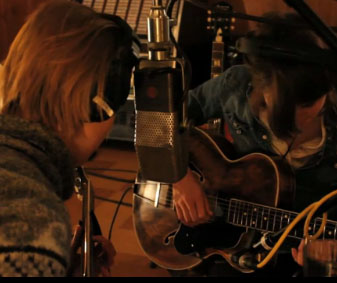
So I was recently watching videos of a band I’ve been following for a while – The Smoke Fairies. The duo are Katherine Blamire and Jessica Davies. I love their folky, bluesy, kind of PJ Harvey-ish music built around simple but brilliant guitar parts with stunning vocal harmonies. Early in 2013 they released a limited edition 7″ vinyl single The Water Waits taken from a recording session recorded back in 2011.
At the time the band were touring in the US with Blitzen Trappen and they recorded a session upstairs at the United Pressing Plant, Nashville.
It seems they press the vinyl records downstairs and have a suite of rooms upstairs that have been used by recording artists for more than 50 years. The “Upstairs” series are all analogue recording sessions – recorded to quarter inch tape and then released as vinyl records.
The video I watched was shot by Luke Norby from the Blitzen Trappen crew and shows members of the band learning songs in the session to provide drums, bass and keys behind the duo as they perform six songs.
I have a background in analogue tape based recording – mostly in radio and to a lesser extent in music. The site of the vintage console and the spools of tapes spinning had me hooked: the whole session is recorded using vintage analogue mics and equipment provided by Chris Mara from the “Welcome to 1979″ recording studio in Nashville.
It’s a while since any band I’ve been in has had to record a song and nail it in a couple of takes with no overdubs allowed (the recording goes straight to quarter inch 2 track stereo tape) So I appreciated watching these musicians working through a long session to get the songs down.
On the one hand I had my musician head on – appreciating the hard work and the rewards of the players. On the other hand my studio engineer head was in gear – interested to note for example, an EV RE20 as an over-head on the drums, the amps out in the corridor with the mics on them, the vintage console – the tapes running at what looks like 15 ips – you have no idea how fascinating all of that is!
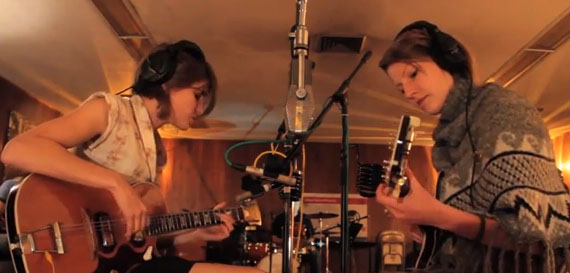
But more than the tape and the vintage console – what really caught my eye was the mic Chris used for recording the vocals. Katherine and Jessica sing together most of the time and have a great musical chemistry so it makes sense to put them head to head on a mic that does a figure of eight configuration. It’s a well established old school recording technique.
Engineer Chris Mara could have used one of his U87’s but instead goes for a real vintage looking silver mic – but what was it? I was intrigued – It was a massive silver metal object like one of those old school radio mics from the 30’s and 40’s that you might see in old black and white news reels.
Actually some research revealed to me that the mic in question is exactly that – it’s an RCA 44 velocity mic, or ribbon mic and it was widely used in broadcasting the 1930’s and for many years thereafter.
I guess these days you might not want to use it for a contemporary pop recording – nevertheless there are quite a few rock artists who rave about the modern recreation of this beast from the past (now available as the AEA R44) which is hand made and comes with a price tag to match. Ribbon mics are favoured by many engineers for stringed instruments as well as voices and you can use them for percussion and brass too.
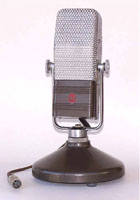
And because it was designed to be used for musical ensembles as well as in radio broadcasts you don’t have to be right on top of it to sound great. Jessica and Katherine in the Smoke Fairies sessions are around a foot away and it sounds fabulous. I did some more on-line research on the RCA 44 (in the process discovering the Coles 4038 BBC ribbon – subject for another post perhaps).
I’d love to get my hands on an original RCA44 – or maybe the AEA R44 – but at the moment their price range puts them into the major investment category (about £3780 for the AEA) still – nice to have something to aspire to. The Coles 4038 on the other hand – while still pretty pricey – is perhaps more within reach and with a great BBC broadcast pedigree may be one to consider for future spoken word work.
You can also see the Smoke Fairies and the RCA44 in action in the video here:
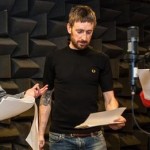 I discovered the story when I saw a photo on the BBC website.
I discovered the story when I saw a photo on the BBC website.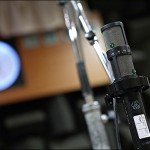 Further research threw up a photo by Edward Moss taken on a recent tour of The Archers’ studio in Birmingham that clearly reveals the actual mic to be an AKG C426 B.
Further research threw up a photo by Edward Moss taken on a recent tour of The Archers’ studio in Birmingham that clearly reveals the actual mic to be an AKG C426 B.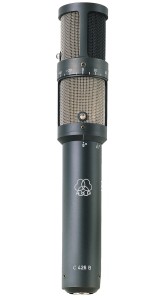 I gleaned from various forums that the C426 B is apparently great for drum overheads, piano, choirs, strings – and as we know the BBC deem it suitable for radio drama recording.
I gleaned from various forums that the C426 B is apparently great for drum overheads, piano, choirs, strings – and as we know the BBC deem it suitable for radio drama recording.




